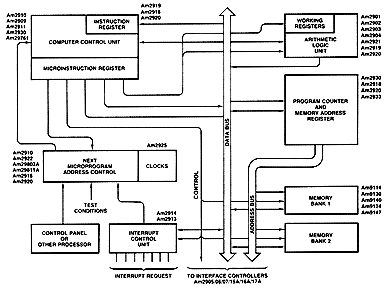Bit-Slice Design: Controllers and ALUs
by Donnamaie E. White
Copyright © 1996, 2001, 2002 Donnamaie E. White
- Pre-Introduction
- Selection of the Implementation
- Microprogramming
- Advantages of LSI
- The 2900 Family
- Language Interrelationships
- Controller Design
- Constructing the CCU
- Sequential Execution
- Multiple Sequences
- Start Addresses
- Mapping PROM
- Unconditional Branch
- Conditional Branch
- Timing Considerations
- Pipelining
- Improved Architecture
3. Adding Programming
Support to the Controller
- Expanded Testing
- Subroutines
- Nested Subroutines
- Stack Size
- Loops
- Am29811
- Am2909/11
- CASE Statement (Am29803A)
- Microprogram Memory
- Status Polling
- Interrupt Servicing
- Implementation - Interrupt Request Signals
- Vector Mapping PROM
- Next Address Control
- Am2910
- Am2910 Instructions
- Control Lines
- Interrupt Handling
- Am2914
- Interconnection of the Am2914
6. The ALU and Basic Arithmetic
- Further Enhancements
- Instruction Fields
- Instruction Set Extensions
- Sample Operations
- Arithmetic -- General
- Multiplication with the Am2901
- Am2903 Multiply
IntroductionLast Edit Ocober 10, 1996; July 9, 2001 Advantages of VLSIIf bipolar has been chosen over MOS because of speed, LSI is preferable to SSI/MSI and VLSI is preferable to LSI for the same reasons. First, costs are reduced with the larger devices. VLSI and LSI require fewer parts and therfore fewer boards and therefore less rack space. (One ASIC VLSI chip can replace a large, 14-layer fully populated SSI/MSI board.) There is less external etch and fewer pin connections as more of the interconnections are moved inside the chip. Second, using LSI improves reliability. Approximately 80% of the failures of working systems are caused by broken etch or bent pins and other broken external connections. This is mechanical failure. Using SSI/MSI a typical controller might use 300 16-pin DIPs, for a total of 4800 pin connections. The same controller done with LSI might use 30 40-pin DIPs, for a total of 1200 external pin connections, the other interconnections having been moved to the inside of the device. The AMD 2900 Family was used in this text. At the time it was published, the 2900 Family was considered industry-standard for bipolar bit-slice devices. It is a microprogrammable family of LSI-level complexity. Table 1-2 summarizes its advantages. Table 1-2 Microprogramming with LSI - Advantages over SSI/MSI designs
The Am2900 FamilyNote: Check out the AMD website - the 2900 family has a third-party emulation available. The Am2900 Family itself is no longer in production. I get e-mail. As of 1981, the Am2900 family included
Consider a simplex block diagram of a basic computer, shown in Figure 1-1. The essential blocks of this diagram are:
Figure 1-1 Simplex system block diagram
The CPU is where data is processed; the CCU is where instructions are processed. From this simple overview (a Von Neuman architecture) , progress to Figure 1-2 and the generalized computer architecture blocked out to show the various members of the 2900 Family and their applications. [Dated material] Figure 1-2 Generalized computer architecture
|
||||||||||
